Despite ‘Shōgun’ Success, TV Is Falling Out of Love With the Miniseries
- Oops!Something went wrong.Please try again later.
- Oops!Something went wrong.Please try again later.
When “Shōgun” first premiered on NBC in 1980, it broke records, scoring the highest weekly numbers in NBC history and drawing an estimated 70 million viewers. Forty-four years later, when FX brought James Clavell’s masterpiece to the small screen for a 10-part limited series, “Shōgun” did it again. Domestically, the first episode ranked as the most streamed FX series in Hulu’s history, ahead of “The Bear” Season 2.
Yet, funnily enough, two adaptations of the same show sit on opposite ends of one particular trend. While the 1980 version of the story helped spark the miniseries boom of the ‘80s, the current version premiered at the height — or possibly the falling peak — of the current miniseries landscape.
“I wouldn’t say so much that we’re not going to make limited series, but I will say that we’re going to make less of them,” John Landgraf, chairman of FX and FX Productions, told TheWrap. “We’re saying goodbye to so many really good and interesting comedies and dramas right now. I really believe that audiences want returning shows, characters and stories that they can stay involved in for years.”
The main reason for the decline of the modern-day miniseries, TV insiders told TheWrap, is that sweeping productions like “Shōgun” are costly and, by their very nature, produce a limited number of episodes. They may be good for drawing in audiences, but they don’t allow networks or streamers to create long-term audience engagement. That runs counter to the priorities of today’s streaming distribution model where success is measured by subscriber counts and minutes viewed — and where audience expectations are changing.
“There’s not as easy of a return on investment if you’re spending all this money, time, energy and creative resources to mount a project, but it’s over in eight episodes and it’s consumed in two days,” Olivia Charmaine Bernardez, founder and CEO of Black Monarch Entertainment, told TheWrap.
That said, the format has become a safe space for the types of projects that may otherwise be doomed to be promising one-offs lost to the noise. That’s the case with PBS series like “Great Performances” and “NOVA.”
“The advantage of a miniseries is that it gives you a little bit more of a footprint,” Paula Kerger, the CEO of PBS told TheWrap. That inevitably helps with promotion and encouraging viewership. “There are some projects that fit better within a shorter footprint than a longer-form series, and so miniseries then work out pretty well for that.”
On the heels of the finale of one of the buzziest and most critically acclaimed series of the year, here’s what led us to this miniseries moment and what may happen next.
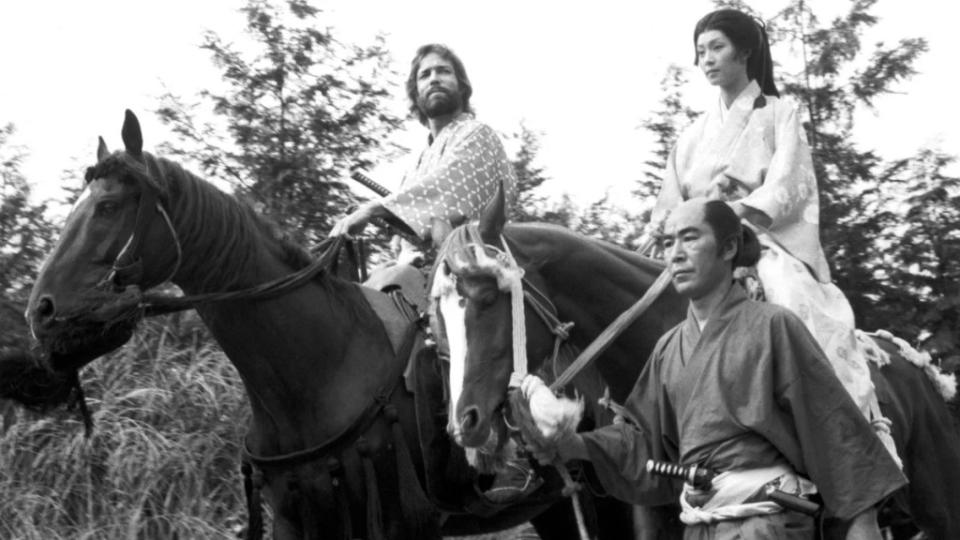
“Shōgun” and the first miniseries boom
For the purposes of this article, “miniseries” is used as an umbrella term to describe both limited series (“The Night Of”) and anthology series (“American Crime Story”). Basically, any TV event that lasts fewer than the typical 22-episode broadcast television season and is a self-contained story with talent that was originally contracted for one season counts as a miniseries.
The first adaptation of James Clavell’s 1975 masterpiece about a fictional English navigator (based on a real historical figure) who journeys to Japan in the early 17th century wasn’t responsible for sparking the primetime miniseries trend. “Roots” was. The 1977 ABC series, an adaptation of Alex Haley’s novel about an African teenager sold into slavery and taken to North America, represented “the pinnacle of the format’s emergence on broadcast television in the 1970s,” Myles McNutt, a TV critic, media scholar and associate professor at Old Dominion University, told TheWrap.
The ABC juggernaut averaged 31.9 million households over its eight nights and won nine Emmys. McNutt likened what “Roots” did for miniseries to what “Survivor” did for reality television — it sparked the flame for this genre to catch fire.
NBC continued the trend with the 1980 version of “Shōgun.” Starring Richard Chamberlain, Toshiro Mifune and Yoko Shimada, it was the first U.S. television production to be filmed entirely in Japan. At the time, the miniseries’ ratings made it the “second most successful series” behind “Roots,” according to The New York Times. This translated into more than a quarter of American households tuning in to watch the miniseries and “Shōgun” took home three Emmys, including one for Outstanding Limited Series.
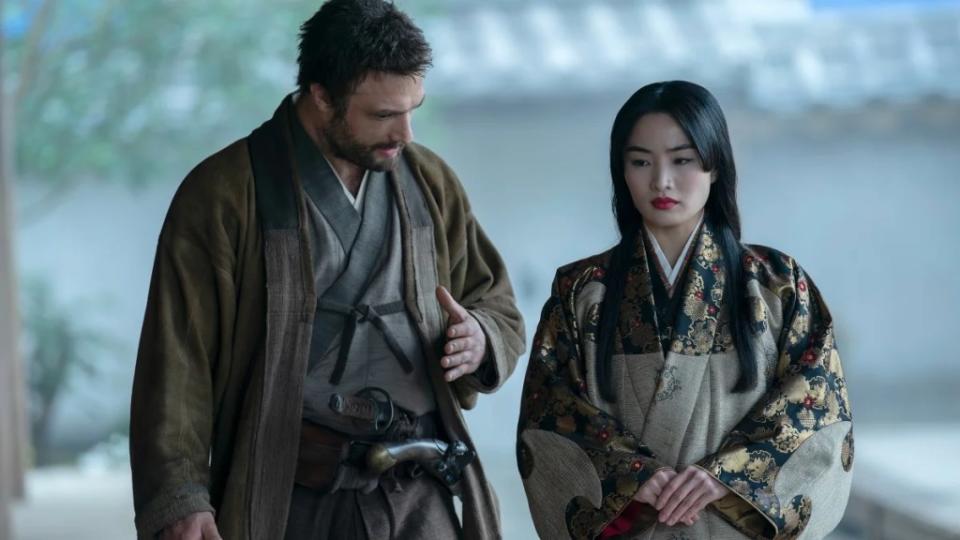
Shortly after the miniseries concluded, New York Times journalist Tony Schwartz noted that its success made the resurgence of the miniseries format “almost inevitable.” That prediction turned out to be true.
In the 1970s, NBC broadcast five miniseries, CBS had one and ABC broadcast 10, including “Roots” and “Roots: The Next Generations.” The following decade, NBC and CBS both had seven miniseries each, and ABC bumped its count up to 14. ABC would continue to release miniseries throughout the 1990s, but the other two networks fell away from the format. CBS only released five miniseries throughout the decade, and NBC didn’t touch the format again until 2005’s “Revelations.”
In today’s TV landscape it’s nearly impossible for FX’s 2024 adaptation to achieve the ratings the 1980 version did. But the series nevertheless has broken records in its own right. In its first six days of streaming, the premiere episode of the series drew 9 million views globally across Hulu, Disney+ and Star+. The series has also appeared in the Top 3 of Samba’s TV weekly Wrap Report every single week it’s released a new episode so far, a feat for a list often dominated by Netflix releases.
Cable and the second big wave
The 1970s and ‘80s may have ignited the miniseries trend, but it didn’t take its current form until cable seriously entered the conversation in the 2010s. Miniseries had always been important to networks concerned with prestige TV like HBO. Yet as cable fragmented television’s audience, it also made these investments less secure for broadcast, especially since they offered no syndication cushion.
“The result was that ‘prestige’ miniseries became limited to cable,” McNutt said, noting that no broadcast series was nominated for the Limited Series Emmy category between 2005’s “Elvis” and 2015’s “American Crime.” Instead, cable and streaming originals were sweeping the competition.
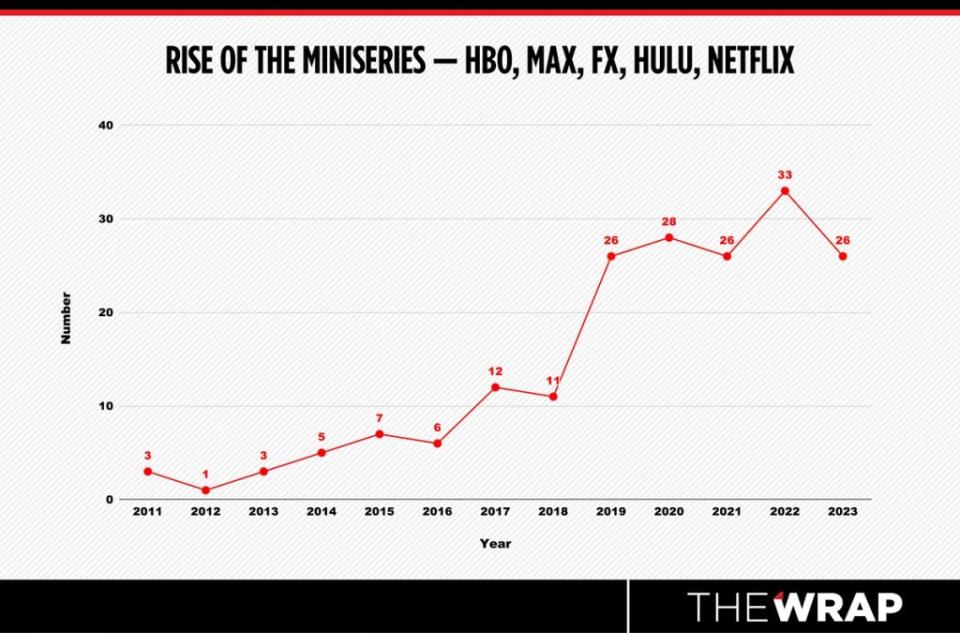
This era saw a combination of established players in the space, such as HBO and PBS, and cable newcomers, like History’s “Hatfield and McCoys” and FX’s “American Horror Story,” vying for attention. This already heated competition only got more intense when streamers entered the race.
“As new streaming platforms emerged, their desire to compete with HBO in matters of ‘quality TV’ made miniseries an easy path to Emmy nominations and the perceived legitimacy therein,” McNutt said.
That evolution has been reflected in the Emmys race for Outstanding Limited or Anthology Series. Since 2011 — the year the “American Horror Story” premiered and the cable race for miniseries really took off — three networks and streamers have handily dominated the space: HBO, FX and Netflix.
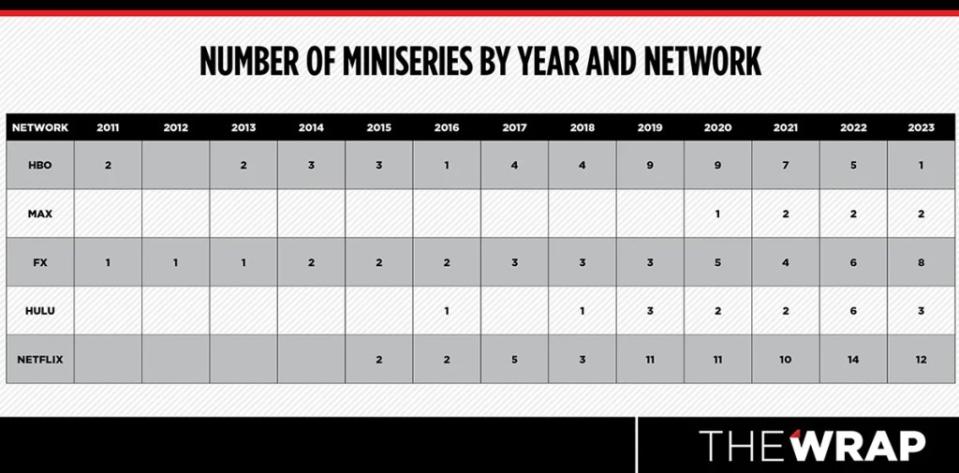
Seventeen nominations in the category have come from HBO, such as “Big Little Lies,” “Chernobyl” and “Watchmen.” FX follows closely behind with 13 nominations for series such as “American Crime Story,” “Fargo,” “Fleishman Is in Trouble” and “Fosse/Verdon.” Netflix comes in third place with eight nominations for series such as “Godless” and “Beef.” Hulu comes in fourth place with four nominations thanks to installments like “The Dropout” and “Little Fires Everywhere.”
It’s clear that the interest in miniseries has increased in recent years. From 2011 to 2016, HBO, FX, Netflix and Hulu didn’t release more than a combined seven miniseries. 2015 saw the most miniseries during this time with FX and Netflix each releasing two entries in this genre and HBO releasing three.
That jumped to 12 major miniseries in 2017, which more than doubled to a staggering 26 in 2019. The numbers continued to increase, especially when Max, formerly titled HBO Max and owned by the same parent company as HBO, entered the fray in 2020.
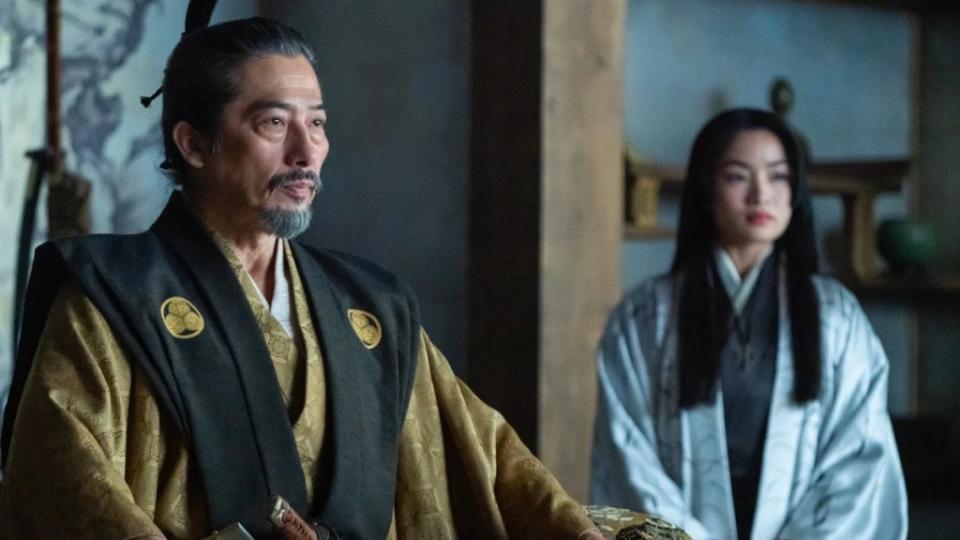
To date, 2022 was the year when the most miniseries were released by these now-five major players. During that year, which saw the likes of “The White Lotus” Season 2, “The Staircase,” “Under the Banner of Heaven” “Inventing Anna” and “Pam & Tommy,” Max released two, HBO released five, FX and Hulu both released six and Netflix released 19, totaling 33 major miniseries in a single year. (It should be noted that animated miniseries and non-English miniseries were excluded from this roundup. If they were included, Netflix’s numbers would be even higher.)
Since then, the amount of miniseries has shrunk. Last year saw 26 released between the major players. So far in 2024, only 16 miniseries have either been released or confirmed.
There are a variety of reasons why this may be the case, from COVID-19 delays ballooning the amount of shows released in 2022 to delays caused by the WGA and SAG-AFTRA strikes postponing 2023 premieres. But there’s another reason why some networks may be pulling back from this particular TV trend: changing audience demands.
The future of the format
“One of the things consumers really, really want is they want libraries,” Landgraf said. “They want to bond with the show and be able to watch that show consistently and over time. “I have a real worry about what happens to television if television doesn’t create the next generation of shows like that.”
Recently, viewership trends support Landgraf’s fears. The show of the summer during 2023 wasn’t a buzzy limited series with A-list stars but the USA original “Suits.” The procedural, which was available on both Netflix and Peacock, raked up 57.7 billion minutes viewed, according to Nielsen. Its wild success even prompted NBC to give a pilot order to its spinoff, “Suits: LA,” nearly five years after the conclusion of the original drama.
That’s not all. More and more, networks and streamers seem to be pivoting toward “blue sky dramas,” aka character-based procedurals that can run for multiple seasons. USA Network announced a recommitment to the genre. CW has been rebuilding its brand partially around these properties thanks to shows like “Sullivan’s Crossing” and “Wild Cards.”
ABC head Craig Erwich has been clear that the network will continue to invest in “long-running procedurals” like “Grey’s Anatomy” and “The Rookie,” a move the network has backed by its acquisition and push of “9-1-1.” Perhaps most shocking of all, Max greenlit “The Pitt,” a medical procedural from “ER” alums Noah Wyle, John Wells and R. Scott Gemmill. It stands as one of the first procedurals a streamer has ordered.
This isn’t to say that miniseries will disappear. From providing room for experimentation to their ability to draw in big stars, miniseries have long had a place on television. PBS, a longtime player in the space, plans to remain dedicated to the format, though its goals are slightly different than the rest of television due to being a public broadcaster that accepts viewer donations.
“It’s not that we don’t look for one-offs. But, in many cases, it’s easier for us to look for a limited, multi-part series to get it on the air. So we lean on those just a little bit more,” Kerger said.
There’s also evidence to suggest audiences are still enjoying these series. According to Samba, the two top viewed shows from Jan. 1 to April 20 were Netflix miniseries: “Fool Me Once” and “Griselda.”
But, as is always the case with television, the miniseries landscape of the future might not look like that of today.
“There may be an argument for reprioritizing different forms of development, but there’s no reason to believe that the miniseries will ever fall out of style,” McNutt said. “It will just evolve to meet the needs of whatever industrial circumstances arrive next.”
The post Despite ‘Shōgun’ Success, TV Is Falling Out of Love With the Miniseries appeared first on TheWrap.

